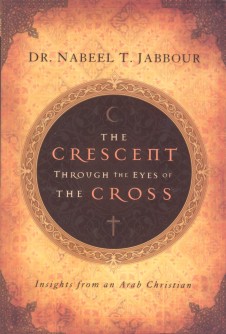 When you consider Muslims, what comes to mind? A terrorist? A suicide bomber? Or perhaps a woman swathed in a black burka? How about the family next door, or your college professor, or perhaps the engineer in the next cubicle?
When you consider Muslims, what comes to mind? A terrorist? A suicide bomber? Or perhaps a woman swathed in a black burka? How about the family next door, or your college professor, or perhaps the engineer in the next cubicle?
Because many Americans don’t personally know anyone who is a Muslim, our mental image may not match reality. Sure, some Muslims are terrorists, but many more are our neighbors and business associates—and perhaps our friends.
If you’d like to go beyond the front page news stories and discover how the “average” Muslim thinks, (if there is such a person), I highly recommend that you read The Crescent through the Eyes of the Cross: Insights from an Arab Christian, by Dr. Nabeel T. Jabour. If you’d like to know how Muslims view Christianity, then I recommend this book even more highly. And if you want to move past stereotypes and fear and learn to love our Muslim neighbors, then get your hands on this book as soon as possible!
Dr. Jabbour is a Syrian Arab who grew up in Lebanon. He believes his family’s Christian heritage dates back to the book of Acts! As an adult, he served for fifteen years as a missionary in Egypt before emigrating to the United States. He has a doctorate in Islamics, but it’s his personal experience of living in three mostly-Muslim countries that enlightens every page.
In a way, the book’s title is backwards. Dr. Jabbour writes about how the gospel and the church and Christians are seen through the eyes of a Muslim, as well as about what Muslims believe. He relates to his readers through a fictitious character named Ahmad, who is a “typical Muslim”—a composite of many Muslims the author has met. Ahmad is an Egyptian college student studying in the United States. He’s a devout Muslim, but is willing to dialog with the American Christians he meets.
Ahmad’s complaints about Christianity are divided into three categories. He addresses three issues that confuse and frustrate him: ”Your Message”; “You, the Messenger”; and “Me, the Receiver.” In all three categories, I could understand why Muslims would be confused and frustrated. As believers, we haven’t done a very good job of explaining our faith, of living it out, or of listening to others.
For me, one of the most helpful parts of the book explains how our Western view of the gospel is only one way to view Scripture. We tend to think in terms of guilt and righteousness, forgiveness and grace. Mid-eastern culture views life differently. They see life in terms of honor and shame, defilement and cleanliness, and fear and power. It’s vital to present the gospel in ways that are sensitive to Arab culture, and this book will help you do just that.
This isn’t a difficult book to read; its conversational style makes for rapid progress. For those who are eager to learn more, there’s an extensive Addendum available for free by email. Questions at the end of each chapter lend themselves to group study.
Eugene H. Peterson sums up why this book is a must-read: “This book is both timely and necessary for Western Christians to read and ponder—timely because Muslims are widely perceived as the enemy, necessary because Christians are under command to love the enemy. Jabbour gives faces and names to Muslims so that we can obey Jesus’ command.”
